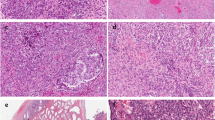Opinion statement
Malignant mesothelioma of the gonads is a rare and highly lethal disease. Most of these tumors arise from the tunica vaginalis, which is a continuation of the mesothelium similar to the pleura and the peritoneum. However, intratesticular and ovarian mesotheliomas have also been described. Occasionally, patients with localized disease at the time of detection have been known to survive for more than 10 years; however, the majority will not live beyond 5 years, with median survival being approximately 23 months. The principle reasons for this are difficulty in making a preoperative diagnosis and advanced stage at the time of treatment. Surgery forms the mainstay of management for all stages of the tumor. Adjuvant therapy in the form of chemotherapy, immunotherapy, or radiotherapy has negligible benefit. It is essential to diagnose this rare entity at the early stages to allow complete surgical extirpation. For the management of localized disease, we suggest the following protocol: initial staging of suspected cases with computed tomographic scan of the abdomen and pelvis; radical inguinal orchiectomy or hemiscrotectomy; retroperitoneal lymph node dissection in cases with positive nodes on scan or biopsy; and inguinal node dissection in cases requiring hemiscrotectomy. For advanced or recurrent disease, we suggest local radical resection with chemotherapy, including high-dose cisplatin and doxorubicin for two cycles of 5 days each; add local radiotherapy for uncontrolled locally advanced disease.
Similar content being viewed by others
References and Recommended Reading
Attanoos RL, Gibbs AR: Primary malignant gonadal mesotheliomas and asbestos. Histopathology 2000, 37:150–159.
Harmse JL, Evans AT, Windsor PM: Malignant mesothelioma of the tunica vaginalis: a case with an unusually indolent course following radical orchidectomy and radiotherapy. Br J Radiol 1999, 72:502–504.
Plas E, Riedl CR, Pfluger H: Malignant mesothelioma of the tunica vaginalis testis: review of the literature and assessment of prognostic parameters. Cancer 1998, 83:2437–2446.
Perez-Ordonez B, Srigley JR: Mesothelial lesions of the paratesticular region. Semin Diagn Pathol 2000, 17:294–306.
Ferri E, Azzolini N, Sebastio N, et al.: Unusual case of mesothelioma of the tunica vaginalis associated with prostatic adenocarcinoma. Minerva Urol Nefrol 2000, 52:33–35.
Gupta NP, Agarwal AK, Sood S, et al.: Malignant mesothelioma of the tunica vaginalis testis: a report of two cases and review of literature. J Surg Oncol 1999, 70:251–254.
Jones MA, Young RH, Scully RE: Malignant mesothelioma of the tunica vaginalis: a clinicopathologic analysis of 11 cases with review of the literature. Am J Surg Pathol 1995, 19:815–825.
Schneider J, Woitowitz HJ: Asbestos-induced malignant mesothelioma of the tunica vaginalis testis. Zentralbl Chir 2001, 126:229–232.
Kanazawa S, Nagae T, Fujiwara T, et al.: Malignant mesothelioma of the tunica vaginalis testis: report of a case. Surg Today 1999, 29:110 6–1110.
Fligiel Z, Kaneko M: Malignant mesothelioma of the tunica vaginalis propria testis in a patient with asbestos exposure. Br J Urol 1995, 75:679–680.
Umekawa T, Kurita T: Treatment of mesothelioma of the tunica vaginalis testis. Urol Int 1995, 55:215–217.
Carp NZ, Petersen RO, Kusiak JF, Greenberg RE: Malignant mesothelioma of the tunica vaginalis testis. J Urol 1990, 144:1475–1478.
Ozols RF, Corden BJ, Jacob J, et al.: High-dose cisplatin in hypertonic saline. Ann Intern Med 1984, 100: 19–24.
Yanagawa H, Sone S, Fukuta K, et al.: Local adoptive immunotherapy using lymphokine activated killer cells and interleukin-2 against malignant mesothelioma: report of 2 cases. Jpn J Clin Oncol 1990, 21: 377–383.
Robinson BWS, Bowman RV, Manning LS, et al.: Interleukin-2 and lymphokine activated killer cells in malignant mesothelioma. Eur Respir Rev 1993, 3:220–222.
Author information
Authors and Affiliations
Rights and permissions
About this article
Cite this article
Gupta, N.P., Kumar, R. Malignant gonadal mesothelioma. Curr. Treat. Options in Oncol. 3, 363–367 (2002). https://doi.org/10.1007/s11864-002-0001-8
Issue Date:
DOI: https://doi.org/10.1007/s11864-002-0001-8




